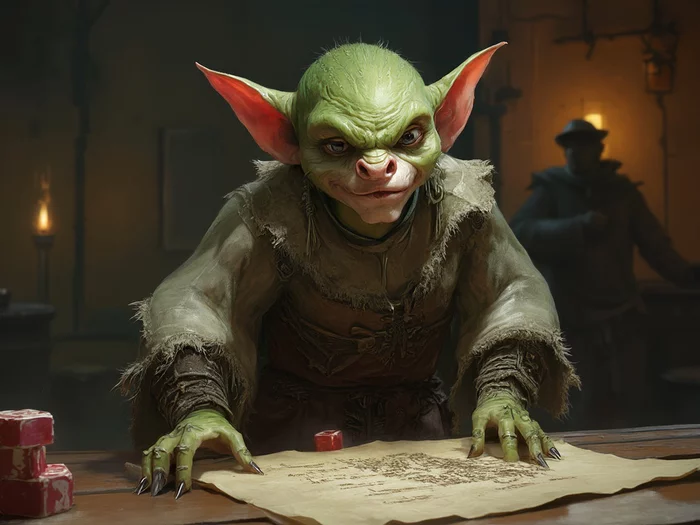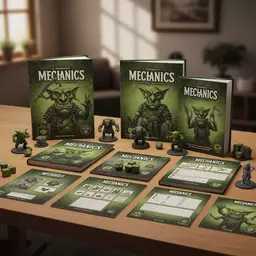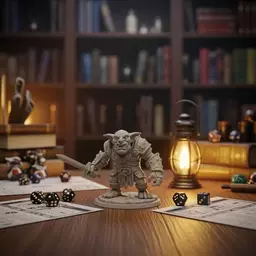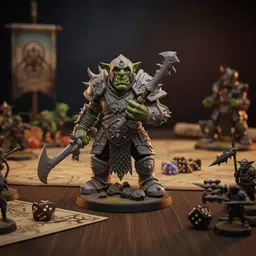Folkloric Origins
- Word: Old French "gobelin"
- Roles: Household spirits, mining entities, tricksters
- Traits: Mischievous, sometimes benevolent
Don't miss out on the latest goblin lore, game mechanics, and homebrew stats. Subscribe to the Goblin Game Guide newsletter!
Posted on: 2025-10-07
By: Lorian Fableweaver
Have you ever wondered how a humble goblin can transform from a mischievous spirit of folklore into a cherished character in tabletop gaming? The journey of goblins is not just a tale of evolution; it’s a narrative rich with charm and chaos that continues to captivate players today.
This visual traces the fascinating transformation of goblins, highlighting their origins in folklore and their subsequent development in fantasy literature and tabletop gaming.
Welcome to our exploration of goblins, where we’ll unravel their intriguing journey from folklore to the vibrant world of tabletop gaming! Goblins have always been a source of fascination, and their evolution is rich with stories and transformations. Let’s dive in!
To truly appreciate goblins in gaming, we need to understand their origins. The word "goblin" traces back to the Old French word "gobelin," which likely comes from a mix of medieval Latin and Germanic roots. In many cultures, goblins were seen as household spirits or mischievous tricksters, often associated with mining and mischief. They were believed to help—or hinder—those who crossed their paths!
Isn’t it fascinating how these traits have carried over into modern gaming? Goblins continue to be a blend of chaos and charm, which makes them so entertaining to include in our campaigns!
Across Europe, goblins exhibit a variety of characteristics that differ by region. For instance, in British folklore, they are mostly depicted as mischievous and sometimes malevolent, while in French tales, they lean towards being more benevolent household helpers. This diversity showcases their adaptability in various narratives.
These characteristics have influenced how we view goblins today, especially in tabletop RPGs like Dungeons & Dragons. They’ve evolved from mere folklore to complex beings that add depth to our gaming experiences!
Now, let's shift our focus to a significant figure who reshaped goblins in modern fantasy: J.R.R. Tolkien. His work has profoundly impacted our understanding of these creatures in literature and gaming!
Tolkien's portrayal of goblins in “The Hobbit” and “The Lord of the Rings” introduced us to a more complex version of these creatures. He depicted them as cunning and often villainous, serving powerful masters like Sauron. This portrayal set the stage for future representations of goblins in literature and games.
Thanks to Tolkien, goblins became a staple in fantasy literature, influencing stories and characters in countless games and novels.
As goblins transitioned from folklore to fantasy literature, their roles evolved significantly. They shifted from ambiguous creatures of mischief to defined characters with distinct personalities and motivations. This transformation has enriched their presence in gaming.
This evolution has allowed Dungeon Masters like myself to weave intricate goblin stories into our campaigns, adding layers of fun and creativity to gameplay!
When incorporating goblins into your tabletop campaigns, consider giving them unique personalities and quirks that reflect their folkloric roots. This not only enriches the narrative but also allows players to engage more deeply with these characters, making them memorable allies or adversaries in your story!
Here are some common questions about the evolution of goblins from folklore to tabletop games:
Goblins hold a special place in both folklore and tabletop RPGs, showcasing their enduring appeal and adaptability in storytelling. From sneaky tricksters in ancient myths to quirky sidekicks or antagonists in modern games, goblins embody a fascinating blend of chaos and charm. Their ability to evolve alongside gaming trends is what makes them so captivating for players of all ages.
In the world of tabletop gaming, goblins often serve as more than just typical foes; they can be allies, comic relief, or even tragic figures. This flexibility enhances the richness of stories told at the game table, allowing for dynamic interactions and memorable moments. Their whimsical nature invites creative interpretations, making them a favorite among players and Dungeon Masters alike!
Goblins significantly influence player engagement and character development within the tabletop gaming community. Their unique traits and personalities often inspire players to incorporate them into their campaigns in distinct ways. Here are a few ways goblins contribute to gaming dynamics:
As a Dungeon Master, I've found that integrating goblins into campaigns not only adds depth but also encourages players to explore their own creativity. Whether they’re crafting backstories or devising strategies, players often find themselves drawn to the whimsical nature of these little green creatures!
What has your experience been with goblins in tabletop RPGs? Have you encountered them as funny sidekicks or cunning adversaries? At Goblin Game Guide, we’re eager to hear your stories and perspectives! Feel free to share your thoughts on how you perceive the evolution of these characters in gaming. Let's build a community rich with goblin lore, camaraderie, and creativity together!
Here is a quick recap of the important points discussed in the article:

 Curious about how the quirky mechanics of goblins can elevate your gaming experience? Unleash the fu
Curious about how the quirky mechanics of goblins can elevate your gaming experience? Unleash the fu
 As you embark on your homebrew journey, the balance of goblin stats can make or break your gaming ex
As you embark on your homebrew journey, the balance of goblin stats can make or break your gaming ex
 Have you ever considered how the smallest creatures can wield the greatest potential? When it comes
Have you ever considered how the smallest creatures can wield the greatest potential? When it comes